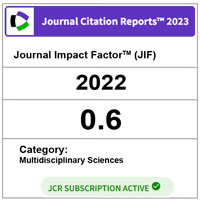Mechanical and degradation properties of polycaprolactone/ zeolite electrospun membrane
DOI:
https://doi.org/10.11113/mjfas.v15n3.1206Keywords:
Polycaprolactone, zeolite, electrospinning, degradationAbstract
Polycaprolactone (PCL) is one of the synthetic polymers used in biomedical applications. PCL has several advantages including biocompatibility, biodegradability and mechanical flexibility. On the other hand, zeolites are microporous, aluminosilicate minerals commonly used as commercial adsorbents. Electrospinning is a promising technique to produce membranes by applying high voltage electricity. In this research, an electrospinning technique was used to fabricate the electrospun membrane based on PCL and zeolite. In order to produce electrospun membrane, 15% (w/v) of PCL polymer solution was dissolved in acetone and 20% (w/v) zeolite was incorporated into the PCL polymer solution. The diameter range of fiber was 2-6 µm. Zeolite nanoparticles were distributed homogenously into the fibers. EDX spectrum confirmed the presence of zeolite throughout the membrane. Mechanical testing revealed that the bi-layered membrane had better mechanical properties than only PCL and PCL/Zeolite membrane. In-vitro degradation experiment was carried out for 21 days and the membranes were characterized after the experiment. The membrane can be potentially used as microfiltration unit to entrap silver contaminants in drinking water. Apart of that, the membranes are prepared with biodegradable, biocompatible, non-toxic materials which are eco-friendly.
References
Cooke, S. L., Whittington, A. R. 2016. Influence of therapeutic radiation on polycaprolactone and polyurethane biomaterials. Materials Science and Engineering C, 60, 78-83.
Hassan, M. I., Sun, T., Sultana, N. 2014. Fabrication of nanohydroxyapatite/poly (caprolactone) composite microfibers using electrospinning technique for tissue engineering applications. Journal of Nanomaterials, 209049, 1-7.
Homaeigohar, S., Elbahri, M. 2014. Nanocomposite electrospun nanofiber membranes for environmental remediation. Materials, 7, 2, 1017-1045.
Hong, S., Kim, G., 2011. Fabrication of electrospun polycaprolactone biocomposites reinforced with chitosan for the proliferation of mesenchymal stem cells. Carbohydrate Polymers, 83, 2, 940-946.
, 49-56.
Lim, M. M., Sun, T., Sultana, N. 2015. In vitro biological evaluation of electrospun polycaprolactone/gelatine nanofibrous scaffold for tissue engineering. Journal of Nanomaterials, 303426, 1-10.
Liu, J., Ma, Y., Xu, T., Shao, G. 2010. Preparation of zwitterionic hybrid polymer and its application for the removal of heavy metal ions from water. Journal of Hazardous Materials, 178, 1-3,1021-1029.
Mallapur, V. P., Oubagaranadin, J. U. K., Lature, S. S. 2013. Synthesis of zeolite from inorganic wastes. Internatonal Journal of Research in Engineering and Technology, 431-434.
Nagamine, S., Matsumoto, T., Hikima, Y., Ohshima, M. 2016. Fabrication of porous carbon nanofibers by phosphate-assisted carbonization of electrospun poly (vinyl alcohol) nanofibers. Materials Research Bulletin, 79, 8-13.
Nalbandian, M. J., Zhang, M., Sanchez, J., Choa, Y. H., Nam, J., Cwiertny D. M., et al. 2016. Synthesis and optimization of Fe2O3 nanofibers for chromate adsorption from contaminated water sources. Chemosphere, 975-981.
Nasreen, S. A. A. N., Sundarrajan, S., Nizar, S. A. S., Balamurugan, R., Ramakrishna, S. 2013. Advancement in electrospun nanofibrous membranes modification and their application in water treatment. Membranes, 3(4), 266-284.
Pillay, V., Dott, C., Choonara, Y. E., Tyagi, C., Tomar, L., Kumar, P., du Toit, L. C., Ndesendo, V. M. 2013. A review of the effect of processing variables on the fabrication of electrospun nanofibers for drug delivery applications. Journal of Nanomaterials, 789289, 1-22.
Rusli, M. S. I. C., Hassan, M. I., Sultana, N., Ismail, A. F. 2017. Characterization of PCL/zeolite electrospun membrane for the removal of silver in drinking water. Jurnal Teknologi, 79, 1-2, 89-95.
Sultana, N., Khan, T. H. 2012. In vitro degradation of PHBV scaffolds and nHA/PHBV composite scaffolds containing hydroxyapatite nanoparticles for bone tissue engineering. Journal of Nanomaterials, 190950, 1-12.
Tan, E. P. S., Ng, S. Y., Lim, C. T. 2005. Tensile testing of a single ultrafine polymeric fiber. Biomaterials, 26, 13, 1453-1456.
Wanjale, S., Birajdar, M., Jog, J., Neppalli, R., Causin, V., Karger-Kocsis, J., Lee, J., Panzade, P. 2016. Surface tailored PS/TiO2 composite nanofiber membrane for copper removal from water. Journal of Colloid and Interface Science, 469, 2016, 31-37.







